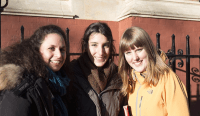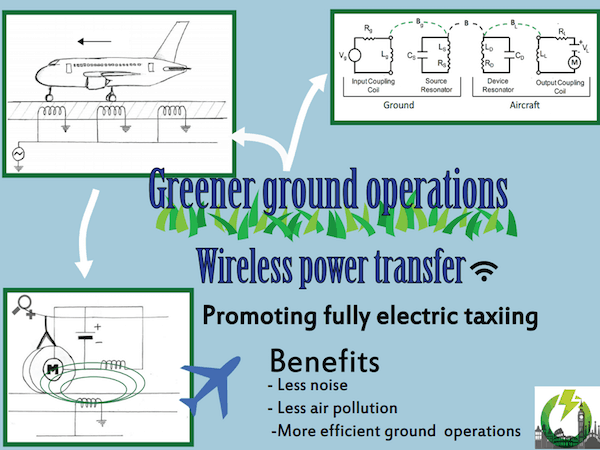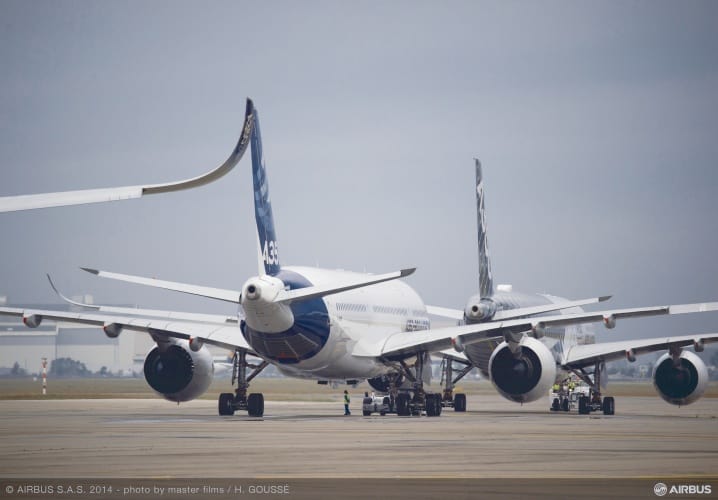This year’s edition sees three PhD students from City University London heading to the finals to compete for a whopping €30,000 first prize.
The team of aeronautics engineering students has beaten off competition from 517 teams originating in 104 countries to reach the final with their solution to wirelessly power aircraft during taxiing.
Similar to the inductive charging method used by Qualcomm in the automotive sector, the solution from City would see jet engines turned off during taxiing, resulting in less fuel burn, less air pollution, and less noise at airports.
Specifically, their WEGO (Wireless and greener ground operations) system would employ transmitter sections on the ground, located just underneath the aircraft in the tarmac, to transfer electrical power inductively to a receiver placed between the nose-wheels. This, they claim, would then provide a sustainable energy source to power ground operations, reducing carbon emissions by half.

Team Bolleboos - Isabella Fumarola, Judit Guimera Busquets and Evelien Van-Bokhorst - are among five teams selected to take part in the final, which takes places in Hamburg on May 27, 2015.
According to Judit, a combination of teamwork, determination and efficiency has taken them this far.
“We got involved in this competition as a kind of joke but when we went through to the second phase we realized that we had a chance to win it,” she told the Student Engineer.
“We got some emails from the university and we just decided to give it a shot, to see if we could come up with some idea that we could send in,’ added Evelein. “Then we did some brainstorming sessions to see what kind of ideas we had.”
The competition itself asks for teams – preferably multidisciplinary – to suggest an innovative idea to tackle one of a number of challenges facing aviation including efficiency, energy, traffic growth, and affordable growth.
One hundred teams made it to Round 2, at which point they were assigned a mentor from Airbus to hone their ideas and develop their ideas further.

The competition, organised in partnership with UNESCO, isn’t linked directly to Airbus’ graduate recruitment scheme, but it does give students an opportunity to showcase themselves, their abilities and their potential future capabilities to Airbus.
Similarly, the competition is not an attempt to lift good ideas from the world’s finest minds.
Prof. Ian Lane (FRAeS), senior expert structural analysis and Fly Your Ideas assessor, Airbus told the Student Engineer that any IP generated by the competition belongs to the students and the institution they’re studying with.
More importantly for Airbus is the opportunity to promote itself to a wider global audience, encourage teamwork, and listen to ideas that are unfettered by convention.
“The student teams, by definition, don’t have the experience that the majority of our engineers have but that does not mean they are inferior to them,” said Prof Lane. “They’re not [however] bound by the convention that we find ourselves thinking along, so it’s a chance to engage both as a business with people who are really imaginative and free thinking but also to remind ourselves internally that we have to keep that spirit alive.
“It’s a real tonic for a lot of our engineers, that’s why we have no trouble recruiting the experts and the mentors to take part in the competition.”
Prof Lane added that ideas that make it to the final are potentially viable and that the entry from Team Bolleboos is entirely feasible, although implementation may require a new business model to make it happen.
“The beauty of working with student teams is they do not self-exclude ideas or some interpretations based on a view of the economics of deployment,” he said. “It’s one of the things that make them so refreshing.”
You can learn more about Team Bolleboos and the Fly Your Ideas competition by clicking here.

Competing against Team Bolleboos:
‘Good vibrations’ energy-harvesting skin – Team ‘MULTIFUN’, Delft University of Technology, Netherlands
MULTIFUN is all about good vibrations. The team’s idea sees plane wings dressed in a composite skin that harvests energy from natural vibrations or flex in the wings. Piezoelectric fibres gather electrical charges from even the smallest movements during flight, storing the energy generated in battery panels integrated in the fuselage and using it to power auxiliary in-flight systems, such as lighting and entertainment systems. This reduces the energy footprint of aircraft during flight and could even replace the entire power source for ground operations.
Drone-guided ‘birdport’ – Team ‘BIRDPORT’, The University of Tokyo, Japan
BIRDPORT proposes deploying a flock of drones or UAVs (unmanned aerial vehicles) to guide birds from airports to a comfortable habitat nearby. The drones use tactics of separation, alignment and cohesion to manipulate flocks and divert them to Birdport, where birdsong and decoys are used to create a natural and safe habitat for birds in the area. The idea is designed to reduce bird strikes to aircraft significantly and to enhance aircraft availability.
Game console-inspired infra-red guidance system – Team AFT-BURNER-REVERSER, Northwestern Polytechnical University, China
AFT-BURNER-REVERSER has applied motion-sensing technology from a games console to an aircraft guidance system for use when taxiing. The model uses infra-red and visual information to warn the pilot and ground crew of high-risk obstacles. This is designed to reduce the turnaround time of aircraft between flights and the cost of damage, saving airlines millions per year.
Faster trolley trash – Team RETROLLEY, University of São Paulo, Brazil
RETROLLEY has tackled the issue of reducing waste in-flight and cutting down the time taken to collect and sort rubbish post-flight, speeding up airline operations particularly on short-haul carriers. The team’s bespoke trolley is designed to intelligently sort rubbish and recycling by minimising the volume of foils, paper and plastic and collecting residual fluid. In doing so, the weight of galley equipment can be reduced by up to 30kg reducing fuel consumption and offering more space in-flight for refreshments.
Source: Airbus




Nanogenerator consumes CO2 to generate electricity
Nice to see my my views being backed up by no less a figure than Sabine Hossenfelder https://youtu.be/QoJzs4fA4fo